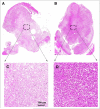Choline PET for monitoring early tumor response to photodynamic therapy
- PMID: 20008981
- PMCID: PMC2999358
- DOI: 10.2967/jnumed.109.067579
Choline PET for monitoring early tumor response to photodynamic therapy
Abstract
Photodynamic therapy (PDT) is a relatively new therapy that has shown promise for treating various cancers in both preclinical and clinical studies. The present study evaluated the potential use of PET with radiolabeled choline to monitor early tumor response to PDT in animal models.
Methods: Two human prostate cancer models (PC-3 and CWR22) were studied in athymic nude mice. A second-generation photosensitizer, phthalocyanine 4 (Pc 4), was delivered to each animal by a tail vein injection 48 h before laser illumination. Small-animal PET images with (11)C-choline were acquired before PDT and at 1, 24, and 48 h after PDT. Time-activity curves of (11)C-choline uptake were analyzed before and after PDT. The percentage of the injected dose per gram of tissue was quantified for both treated and control tumors at each time point. In addition, Pc 4-PDT was performed in cell cultures. Cell viability and (11)C-choline uptake in PDT-treated and control cells were measured.
Results: For treated tumors, normalized (11)C-choline uptake decreased significantly 24 and 48 h after PDT, compared with the same tumors before PDT (P < 0.001). For the control tumors, normalized (11)C-choline uptake increased significantly. For mice with CWR22 tumors, the prostate-specific antigen level decreased 24 and 48 h after PDT. Pc 4-PDT in cell culture showed that the treated tumor cells, compared with the control cells, had less than 50% (11)C-choline activity at 5, 30, and 45 min after PDT, whereas the cell viability test showed that the treated cells were viable longer than 7 h after PDT.
Conclusion: PET with (11)C-choline is sensitive for detecting early changes associated with Pc 4-PDT in mouse models of human prostate cancer. Choline PET has the potential to determine whether a PDT-treated tumor responds to treatment within 48 h after therapy.
Figures





Similar articles
-
High-field magnetic resonance imaging of the response of human prostate cancer to Pc 4-based photodynamic therapy in an animal model.Lasers Surg Med. 2007 Oct;39(9):723-30. doi: 10.1002/lsm.20576. Lasers Surg Med. 2007. PMID: 17960753 Free PMC article.
-
Assessment of PET tracer uptake in hormone-independent and hormone-dependent xenograft prostate cancer mouse models.J Nucl Med. 2011 Oct;52(10):1654-63. doi: 10.2967/jnumed.110.086702. Epub 2011 Aug 22. J Nucl Med. 2011. PMID: 21859811
-
Choline Molecular Imaging with Small-animal PET for Monitoring Tumor Cellular Response to Photodynamic Therapy of Cancer.Proc SPIE Int Soc Opt Eng. 2009;7262:726211. doi: 10.1117/12.812129. Epub 2009 Feb 27. Proc SPIE Int Soc Opt Eng. 2009. PMID: 23336060 Free PMC article.
-
High-resolution PET imaging for in vivo monitoring of tumor response after photodynamic therapy in mice.J Nucl Med. 1999 May;40(5):876-82. J Nucl Med. 1999. PMID: 10319764
-
Diffusion-weighted MRI for monitoring tumor response to photodynamic therapy.J Magn Reson Imaging. 2010 Aug;32(2):409-17. doi: 10.1002/jmri.22247. J Magn Reson Imaging. 2010. PMID: 20677270 Free PMC article.
Cited by
-
Early assessment of radiation response using a novel functional imaging modality -- [18F]fluorocholine PET (FCH-PET): a pilot study.Discov Med. 2012 Jul;14(74):13-20. Discov Med. 2012. PMID: 22846199 Free PMC article. Clinical Trial.
-
3D Prostate Segmentation of Ultrasound Images Combining Longitudinal Image Registration and Machine Learning.Proc SPIE Int Soc Opt Eng. 2012 Feb 23;8316:83162O. doi: 10.1117/12.912188. Proc SPIE Int Soc Opt Eng. 2012. PMID: 24027622 Free PMC article.
-
Positron Emission Tomography Imaging of Tumor Cell Metabolism and Application to Therapy Response Monitoring.Front Oncol. 2016 Feb 29;6:44. doi: 10.3389/fonc.2016.00044. eCollection 2016. Front Oncol. 2016. PMID: 26973812 Free PMC article. Review.
-
Nonrigid point registration for 2D curves and 3D surfaces and its various applications.Phys Med Biol. 2013 Jun 21;58(12):4315-30. doi: 10.1088/0031-9155/58/12/4315. Epub 2013 Jun 4. Phys Med Biol. 2013. PMID: 23732538 Free PMC article.
-
Biodistribution Study of Nanoparticle Encapsulated Photodynamic Therapy Drugs Using Multispectral Imaging.Proc SPIE Int Soc Opt Eng. 2013 Mar 29;8672:10.1117/12.2006492. doi: 10.1117/12.2006492. Proc SPIE Int Soc Opt Eng. 2013. PMID: 24236230 Free PMC article.
References
-
- Triesscheijn M, Baas P, Schellens JH, Stewart FA. Photodynamic therapy in oncology. Oncologist. 2006;11:1034–1044. - PubMed
-
- Oleinick NL, Morris RL, Belichenko I. The role of apoptosis in response to photodynamic therapy: what, where, why, and how. Photochem Photobiol Sci. 2002;1:1–21. - PubMed
-
- Weersink RA, Bogaards A, Gertner M, et al. Techniques for delivery and monitoring of TOOKAD (WST09)-mediated photodynamic therapy of the prostate: clinical experience and practicalities. J Photochem Photobiol B. 2005;79:211–222. - PubMed
-
- Zaak D, Sroka R, Stocker S, et al. Photodynamic therapy of prostate cancer by means of 5-aminolevulinic acid-induced protoporphyrin IX: in vivo experiments on the dunning rat tumor model. Urol Int. 2004;72:196–202. - PubMed
Publication types
MeSH terms
Substances
Grants and funding
LinkOut - more resources
Full Text Sources
